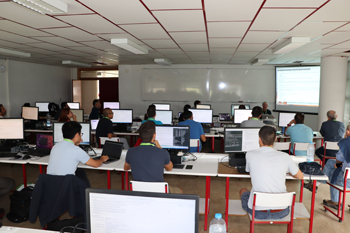
From September 5th to 7th, a team from Jet Propulsion Laboratory (JPL/NASA) had been at UBI to teach how to use GipsyX. This new software version has now replaced GIPSY-OASIS as JPL’s flagship GNSS data analysis software.
This course, which was attended by 25 researchers, covered the fundamentals of using the GipsyX software package to perform static and kinematic precise point positioning of terrestrial stations from GNSS data. The course was attended by researchers from Brazil, Canada, Colombia, Spain, the United States, France, Greece, Holland, Italy, Norway, Portugal, Seychelles, Sweden, Turkey and Ukraine.
Two experts with extensive knowledge on the subject were responsible for presenting the new release of the software. William Bertiger, as a member of the Orbiter and Radio Metric Systems Group, pioneered many of the Global Positioning System (GPS) applications in Science and Technology. Paul Ries works with the GIPSY-OASIS team on several projects.
GNSS data analysis – “The course, which is fundamental to researchers working on GNSS data analysis, has focused on the fundamentals of using GipsyX software to perform precise static or kinematic positioning of ground stations from GNSS (Global Navigation Satellite System) data,” explained Rui Fernandes, head researcher of SEGAL (Space and Earth Geodetic Analysis Laboratory).
Hands-on processing – The class were presented using hands-on processing of GNSS data by each participant, with an emphasis on GPS data. Class presentations walked through specific examples to derive GNSS-based observations of station position, clock, and troposphere.
Collaboration – Dr. Yoaz E. Bar-Sever and Dr. David Murphy, both from JPL (NASA), were also present at the course. Dr. Yoaz Bar-Sever is a senior engineer at NASA’s Jet Propulsion Laboratory (JPL), where he is currently program director for NASA’s Global Differential GPS. Dr. David Murphy is the supervisor of JPL’s Near-Earth Tracking Applications Group. They had the opportunity to discuss with Prof. José Páscoa, UBI´s vice-rector, the continuation of the collaboration project between UBI and JPL, started in 2016.
